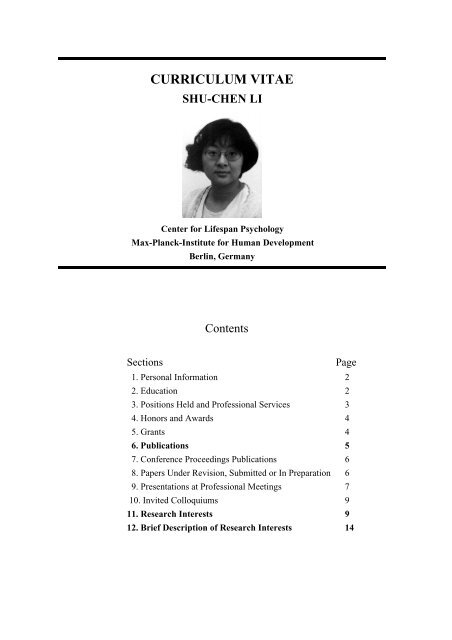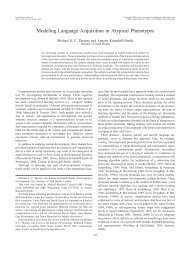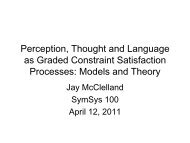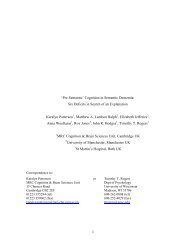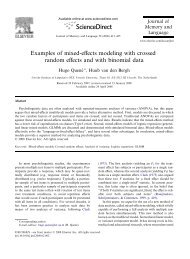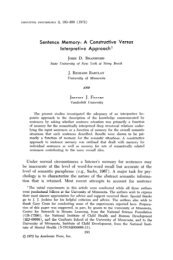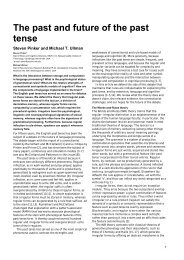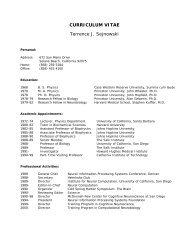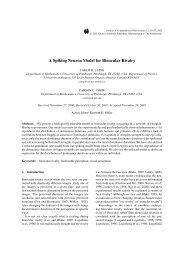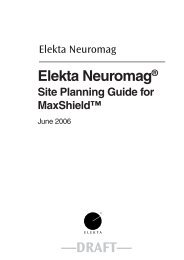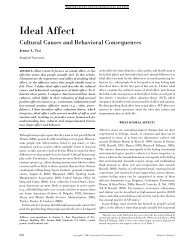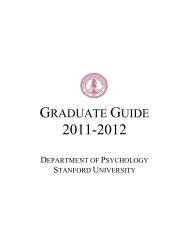CURRICULUM VITAE - Psychology
CURRICULUM VITAE - Psychology
CURRICULUM VITAE - Psychology
You also want an ePaper? Increase the reach of your titles
YUMPU automatically turns print PDFs into web optimized ePapers that Google loves.
<strong>CURRICULUM</strong> <strong>VITAE</strong>SHU-CHEN LICenter for Lifespan <strong>Psychology</strong>Max-Planck-Institute for Human DevelopmentBerlin, GermanyContentsSectionsPage1. Personal Information 22. Education 23. Positions Held and Professional Services 34. Honors and Awards 45. Grants 46. Publications 57. Conference Proceedings Publications 68. Papers Under Revision, Submitted or In Preparation 69. Presentations at Professional Meetings 710. Invited Colloquiums 911. Research Interests 912. Brief Description of Research Interests 14
Curriculum Vitae, Shu-Chen Li21. Personal InformationDate of Birth: May 29th, 1967Occupation: Research ScientistMax-Planck Inst. for Human DevelopmentAddress: Max-Planck Inst. for Human DevelopmentLentzeallee 94D-14195 BerlinGERMANYPhone: +49-30-82406-305Fax: +49-30-824-9939E-mail: shuchen@mpib-berlin.mpg.deURL: http://www.mpib-berlin.mpg.de/lip/staff/li-shuchen.htmhttp://www.mpib-berlin.mpg.de/lip/SC_Li/ShuChenLi.htm2. EducationPh.D. 1994 (Dec. 16th, 1994) University of Oklahoma, OK (Cognitive <strong>Psychology</strong>)Dissertation Title: An Alternative Technique for Model Comparison: ParameterSensitivity and Interdependence Analysis in Models of Cognition.M.Sc., 1991 (Dec. 20th, 1991) University of Oklahoma, OK (Cognitive <strong>Psychology</strong>)Thesis Title: Constraints for Models of Serial Order Memory: DifferentiatingBetween Serial Position Curves in Forward and Backward RecallB.Sc., 1990 (May 5th, 1990) Oklahoma City University, OK (<strong>Psychology</strong>)Associate, 1988 (June, 1988) National Taichung Teachers' College , Taichung, Taiwan,R. O. C. (School Counseling)
Curriculum Vitae, Shu-Chen Li33. Positions Held and Professional ServicesFaculty Research ScientistMax Planck Institute for Human Development (Berlin, Germany) from Sept. 11998 to present.Postdoctoral Research Fellow1. McGill University and Université Laval (Canada) from Sept. 1994 to Sept. 19952. Max-Planck-Institute for Human Development (Berlin, Germany)from Sept. 1995 to Aug. 1998.Courses Taught1. Introductory <strong>Psychology</strong> (Instructor: Summer 1991& Summer 1993 at U ofOklahoma, Norman, OK)2. Experimental Design (Lab Instructor: Spring, 1992 to Spring, 1994 at U ofOklahoma, Norman, OK)3. Introductory Statistics (Instructor: Summer 1995 at McGill University, MontrealCanada)4. Workshop on Neural Network Modeling for Applications in <strong>Psychology</strong> (Dec. 5to 7, 1997 at National Taiwan University, Taipei, Taiwan)Research Assistantship1. Research Assistant for Automation of Air Traffic Control Project of the USAFederal Aviation Administration(Aug.-Dec., 1990).2. Research Assistant for Cluster Detection in Mortality Maps Project of the USADepartment of Health and Human Service (June-Aug., 1992)S er vice to Pr of ess ion al Jou r n alsM ember of the Boar d of Cons ulting Editor s of Ps ychology and Aging ( A PA J ounral) in2001.F r om 1998 to 2001 I have als o been ad hoc r eview er s f or the f ollow ing jour nals :1. J ournal of G er entology: P s ychological S cience2. Connection S cience3. Psychological ResearchService to Professional Meetings1. Paper discussant at the 17 t h M eeting of the Br uns w ik Conf erence, 2000.2. Co- convener of the s ympos ium on Connecting the M any L evels and Facets ofCognitive Aging: A Rendez vous of Behavior al, Com putational and Neur obiologicalApproaches f or the Thir d I nter national Conf er ence on Memor y (J uly 16- 20 t h , 2001,
Curriculum Vitae, Shu-Chen Li4V alencia, Spain) . P r ogr am of the s ympos ium can be view ed athttp://www.uv.es/icom-3/SYMPOSIA1.html#anchor130192.S u per vis ed Ph D and M as ter S tu den tsF lorian S chmiedek ( P h.D .)O liver H uxhold ( Mas ter )4. Honors and AwardsJuly 13, 1998 Elected fellow of the Summer Institute for Young Scholars on TheEvolution of Intelligence organized by the German-American AcademicCouncil. (More information about the aims of this particular summerinsititute can be found at the web address:http://artsci.wustl.edu/~bkeeley/gaac/gaac.html)April 18, 1995 University of Oklahoma 1994-1995 Dissertation Prize in the area of LifeSciences, Social Sciences, Business and Other Professions ($1000.00.One awarded per year).March 5, 1993 Oklahoma Psychological Society: Graduate Research Award: First Place($100.00)April 5, 1991 Oklahoma Psychological Association: First-place research Award($300.00)March 27, 1992 Oklahoma Psychological Society: Graduate research of excellence($200.00)5. GrantsNov. 1997 National Science Council of the Republic of China (Taiwan)Traveling Grant ($1000.00)1994-1995 Research Grant from Faculté des Sciences Sociales de l’UniversitéLaval (≈$17,000.00)Nov. 1993 OU Graduate Student Senate Conference Fee Grant ($125.00)May, 1993 American Psychological Society Student Traveling Grant ($125.00)March, 1993 OU Graduate Student Senate Conference Fee Grant ($200.00)Oct. 21, 1992 OU Graduate Student Senate Conference Fee Grant ($120.00)April 16, 1991 Sigma Xi, The Scientific Research Grant ($300.00)March, 1991 University of Oklahoma President's Fund Research Grant ($250.00)1989-1990 Oklahoma Methodist Scholarship via Oklahoma City University(≈$12,000.00)
Curriculum Vitae, Shu-Chen Li6Lewandowsky, S., & Li, S.-C. (1994a). Catastrophic interference in neural networks:Causes, solutions and data. In F. K. Dempster, & C. J. Brainerd (Eds.), Newperspectives on interference and inhibition in cognition. New York: AcademicPress.Lewandowsky, S., & Li, S.-C. (1994b). Memory for serial order revisited. PsychologicalReview, 101, 539-543.Lewandowsky, S., Hermann, D. J., Behrens, J. T., Li, S.-C., Pickle, L., & Jobe, J. B.(1993). Perception of clusters on statistical maps. Applied Cognitive <strong>Psychology</strong>, 7,533-551.Li, S.-C., & Lewandowsky, S. (1993). Intra-list distractors and recall direction:Constraints on models of memory for serial order. Journal of Experimental<strong>Psychology</strong>: Learning, Memory, & Cognition, 19, 895-908.7. Conference Proceedings PublicationsDeBrunner, V. E., Li, S.-C., & Lewandowsky, S. (May,1996). Sensitivity and learning oftwo digital artificial neural network structures. ISCAS'96, Atlanta, GA, vol. III, pp.445-448.8. Papers Under Revision, Submitted or In PreparationLi, S.-C., DeBrunner, V. E., & Lewandowsky, S. (paper under revision with conditonalacceptance for Neural Computation: submitted March 31st). A Combined Measureof Weight Sensitivity and Interdependence as an Indicator of Network Complexityand Convergence Rate.Li, S.-C., Lindenberger, U., Prinz, W., Baltes, P. B. and the CoOP-MIND ResearchTeam. (paper in preparation). A lifetime from differentiation to dedifferentiation:The Fall and Rise of Covariations between Intelligence, Information Processingand Sensory Functioning across the Lifespan.Li, S.-C. and Singer, T. (paper in preparation). Culture Orchestrates Brain: TheConcerted Influences of Culture and Brain in tuning the Mind’s Epigenesis.Hommel, B., Li, K.Z.H., and Li, S.-C. Visual search across the lifespan. (paper inpreparation).Li, S.-C., et al. Lifespan differences in the relationships between interindividualdifferences in intellectual abilities and cognitive task demands (paper inpreparation).Li, S.-C. (paper in preparation). A Unified Principle for Cognitive Aging andDevelopment?: A Computational Inquiry of the Link Between Dopaminergic
Curriculum Vitae, Shu-Chen Li7Neuromodulation and the Differentitation and Dedifferentiation of CognitiveAbilities Across the LifespanLi, S.-C. (paper in preparation). Variance of Shared Information and the Covariationbetween Information-sharing processes.9. Presentations at Professional MeetingsLi, S.-C., Lindenberger, U., & Baltes, P. B. (2000, July). Functional Task Demand Costsand Intellectual Abilities across Lifespan. Paper presented at the XXVIIInternational Congress of <strong>Psychology</strong>. Stockholm, Sweden.Li, S.-C., Lindenberger, U., & Baltes, P. B. (2000, Apr). The Rise and Fall of theCovariations bteween Intelligence, Its Elementary Cognitive and SensoryCorrelates Across the Lifespan. Paper presented at the 2000 Cognitive AgingConference. Atlanta, Georgia.Li, S.-C., Lindenberger, U., & Baltes, P. B. (1999, Sept.). Relating Intellectual Functioingwith Elementary Cognitive Tasks Across the Lifespan. Paper presented in at theSymposium on Old Age and Cognitive Development at the 9 th EuropeanDevelopmental <strong>Psychology</strong> Conference. Spetses, Greece.Li, S.-C. (1999, Augest). Complexity as Parameter Sensitivity and Interdependency:Applications to Models of Perceived Depth and Network Classifiers. Paperpresented at the Symposium on Model Complexity at the 32nd AnnualMathematical <strong>Psychology</strong> Meeting. Santa Cruz, CA., USA.Li, S.-C., Lindenberger, U., & Frensch, P. A. (1999, July). Unifying Levels of CognitiveAging: From Neurotransmission to Representation to Cognition. Paper presented atthe Eighth Annual Computational Neural Science Meeting. Pittsburgh, USA.Li, S.-C., Lindenberger, U., & Baltes, P. (1998, June). Identifying patterns ofintraindividual change under conditions of substantial and selective mortality: Theexample of perceptual speed in old and very old age. Paper presented at the XV thISSBD (International Society of the Studies of Behavioral Development) meetings.Bern, Switzerland.Li, S.-C., Aggen, S. H., Featherman, D., Nesselroade, J. R., & Baltes, P. B. (1998, April).The link between sensorimotor and memory functioning via intraindividualvariability. Paper presented at the 1998 Cognitive Aging Conference. Atlanta,GeorgiaLacouture, Y., Li, S.-C., & Marley, A. A. J. (1997, Dec.). Number of Stimuli or numberof responses? Implications for models of absolute identification. Paper presented atthe 8th Australian Mathematical <strong>Psychology</strong> Conference. Perth, Australia.
Curriculum Vitae, Shu-Chen Li8Li, S.-C., Lindenberger, U., & Frensch, P. (1997, Dec.). A Computational Exploration ofthe Link Between Cognitive Aging and Brain Catecholamines Via the GainParameter. Paper presented at the 8th Australian Mathematical <strong>Psychology</strong>Conference. Perth, Australia.Li, S.-C., Lindenberger, U., & Frensch, P. (1996, July). What you gain is what you lose:Using the gain parameter to model learning and memory deficits in aging. Paperpresented at the 2nd International Conference on Memory. Abano Terme, Italy.Li, S.-C., Lindenberger, U., & Frensch, P. (1996, April). Interference, reducedprocessing resources, and cortex: In search of a general computational frameworkfor theories of cognitive aging. Paper presented at the 6th Cognitive AgingConference. Atlanta, GeorgiaLi, S.-C. (1995, June). Interference, inhibition and cortex: A connectionist approach tolearning and memory deficits in aging. Paper presented at the 1st Workshop ofNetwork Modeling for Cognitive and Brain Disorder. University of Maryland,College Park, MD.DeBrunner, V. E., Li, S.-C., & Lewandowsky, S. (1995). Sensitivity and learning of twodigital artificial neural network structures. Paper presented at the InternationalSymposium Circuits and Systems.Li, S.-C. (1994, November ). Dimensional attention learning and contingency judgment:A demonstration with adaptive learning networks. Paper presented at the Society ofJudgment and Decision Making, St. Louis, MO.Li, S.-C., DeBrunner, V. E., & Lewandowsky, S. (1994, August). Sensitivity to weightvariation in network models. Paper presented at the 27th Mathematical <strong>Psychology</strong>Meetings, Seattle, WA.Li, S.-C., & Lewandowsky, S. (1993, November). Evidence for separate retrievalprocesses in forward and backward serial recall. Paper presented at the 34thAnnual Meeting of the Psychonomics Society, Washington, DC.Li. S.-C., Lewandowsky, S., Gronlund, S., & DeBrunner, V. (1992, August). Parametersensitivity in models of recognition memory. Paper presented at the 25thMathematical <strong>Psychology</strong> Meetings, Stanford, CA.Li, S.-C., & Lewandowsky, S.(1991, August). Intra-list distractors and recall direction:Constraints on models of memory for serial order. Paper presented at the 24thMathematical <strong>Psychology</strong> Meetings. Bloomington, IN.Li, S.-C. (1991, June). Difference of primacy effect between forward and backwardrecall. Paper presented at the Third American Psychological Society AnnualConvention, Washington, DC.
Curriculum Vitae, Shu-Chen Li910. Invited ColloquiumNov. 2000 Dept. of Neurology, Unveristy Medical Center of the Free Univesity ofBerlin, Berlin, Germany.Jan. 1999 Dept. of Life Sciences and Institute of Neuroscience, National Yang-MingUniversity, Taipei, TaiwanDec. 1998 Inst. of <strong>Psychology</strong>. Humboldt University, Berlin Germany.Sept. 1998 Max Planck Institute for Psychological Research, Munich GermanyApr. 1998 Department of <strong>Psychology</strong>, Syracuse University, USA.Dec. 1997 Workshop of Artificial Neural Networks for Applications in <strong>Psychology</strong>Department of <strong>Psychology</strong>, National Taiwan University, Taipei, TaiwanJuly, 1997 BPS SAB Research Seminar 1997: Models for Age-related Change inMemory. Pershore, England.Feb., 1997 Center of Psychological Gerontology, Free University of Berlin, GermanyMay, 1996 Department of <strong>Psychology</strong>, DePaul University, Chicago, USA.Dec., 1996 Department of <strong>Psychology</strong>, Potsdam University, Potsdam, GermanyJuly, 1995 Department of <strong>Psychology</strong>, University of Toronto, Toronto, Canada11. Research InterestsIn a broad sense, my research stretches across behavioral studies of cognition in alifespan development perspective, cognitive neuroscience and quantitative modeling. Iwould define myself as a very theoretically inclined cognitive psychologist, who isinterested in constructing and evaluating, both analytically and empirically,computational theories of low-level cognition (i.e., memory and perceptual processes,phenomena related to attentional and inhibitory mechanisms, and variables that fit in thecategory of the so-called cognitive mechanics of intelligence).In terms of quantitative orientations (i.e., the specific modeling approaches I use), Ido not restrict myself to work only with a particular class of models. However, mytheoretical orientation is quite specific. I am particularly interested in taking a cross-levelapproach to develop theories of cognition that integrate behavioral data both withtheoretical constructs defined at the information-processing level, and with their potentialbiological underpinnings.In the following sections, I first briefly present the types of quantitative approachesthat I have taken to study memory, age-related cognitive deficits and the link betweencognitive and sensory functioning. I then present my specific theoretical orientation inmore details and show examples of theoretical, empirical and methodological projectsthat I have undertaken that are all guided by this cross-level integration orientation. I endby describing future research directions.
Curriculum Vitae, Shu-Chen Li10Quantitative OrientationsI have worked with more traditional mathematical models, statistical models (i.e.,structural equation models) and neural networks. For instance, in the articles by Li andLewandowsky (1993, 1995) and Lewandowsky and Li (1994), two mathematical modelsof memory (i.e., Theory of Distributed Associative Memory, Murdock, 1982; TemporalDistinctiveness Theory, Glenberg & Swanson, 1986 ) were tested and compared, bothempirically and analytically. In my more recent works, the neural network approach wastaken to model aging-induced cognitive deficits (e.g., the manuscript by Li, Lindenberger& Frensch, under revision in Psychological Review), and structural equation models wereused to examine the relationship between low-level sensory functioning andpsychometrically defined intelligence (Li, Jordanova & Lindenberger, manuscriptsubmitted to Intelligence). Moreover, because of my experiences in working withdifferent types of models, I have often been confronted with the issue of modelcomparison. To investigate this issue, I am also interested in developing quantitativeapproaches to examine the relationship between the formal properties of a model (i.e., itsarchitecture and parameter dynamics) and its falsifiability (e.g., Li, Lewandowsky &DeBrunner, 1996). Taken together, in terms of quantitative methods, I feel it may belimiting to commit to a specific class of approaches. I choose whatever mathematicaltools that seem to best model and address the phenomena that interest me.Specific theoretical orientation: A Cross-level Integrative FrameworkContrary to the flexibility that I give myself in choosing different quantitativemethods, I restrict myself to a specific but, arguably, broad theoretical orientation. I verymuch agree with Llinas & Churchland’s (1996) view on a mind-brain continuum, andMarr’s (1982) assertion that cognition can only be understood completely when differentlevels of explanations are combined and integrated. The specific theoretical orientationthat I am committed to is a cross-level approach for developing theories of cognition.With this I mean that I am interested in modeling cognitive behavioral data bymathematically implementing neurological mechanisms that might have bearings onprocessing mechanisms that have already been defined at the information-processinglevel (such as processing speed, attention, inhibition, and the size of working memory).Indeed, cross-level relationships of such kinds are, in general, not easily identifiable andare even harder to pin down. However, I believe, along with many cognitiveneuroscientists, difficulty alone should never be taken as an argument against this crosslevelintegration approach to the study of cognition.
Curriculum Vitae, Shu-Chen Li11In my own view, difficulties associated with the cross-level approachnotwithstanding, parallelisms and potential causal relationships across the behavioral,information-processing and biological level may reveal themselves more apparently incases where clear but gradual gains or losses occur both at the brain and the behaviorallevel. The condition of gradual gain or loss provide us opportunities to observe patternsof covariations, either within or between persons, across levels. Following this rationale, Ithink that empirical data of cognitive aging and (or) cognitive development provide easiergrounds for constructing and testing cross-level theories of cognition.An example of modeling cognitive-aging deficits. Hence as a start, I undertook thetask to model existing benchmark data of aging-induced cognitive deficits byimplementing a computational mechanism that mimics aging-induced degeneration inneurotransmitter systems (Li, in press; Li, Lindenberger & Frensch, 2000; Li &Lindeneberger, 1999). In accord with the agenda of cognitive neuroscience, the goal ofthis paper is not to propose yet another alternative theory of cognitive aging, rather it is tosearch for a suitable computational framework that would facilitate the integration of theexisting theories of cognitive aging at the behavioral, information processing andbiological level. Previously it was shown that the gain parameter of the logistic activationfunction of artificial neural networks can mimic the modulatory effects of catecholamines(e.g. Servan-Schreiber, Cohen & Printz, 1990). Associating the gain parameter with ageinduceddegeneration in the catecholamine systems, we simulated “aged” cognitivesystems by attenuating the gain parameter which leads to low responsivity of theprocessing units and high internal variability within the system. Results from sixsimulations showed that reduction in the gain parameter is able to account for age-relateddifferences in learning rate, maximum-level performance, susceptibility to interferenceand task demands, and intra- and interindividual variability.An empirical extension across the lifespan. Guided both by my general cross-leveltheoretical orientation and the attempt to develop a further test of the theoretical linkbetween catecholamines and aging-induced cognitive deficits that was put forth in thetheoretical framework by myself and colleagues (e.g., Li, in press; Li & Lindenberger,1999; Li, Lindeneberger & Frensch, 2000) we have collected data on a simplebehavioral/neurophysiological indicator that has been shown in developmental studies tobe indicative of the efficacy of the dopaminergic system as a function of development.The data were collected from a sample of more than 300 participants, ranging from six to87 years old. At the same time, behavioral data were collected from a battery of tenexperimental cognitive tasks, and a battery of psychometric tests of intelligence. Thebroad age range and the breath of the types of variables included in this study provide us
Curriculum Vitae, Shu-Chen Li12information both on the rate of change in these variables and patterns of covariationbetween variables at the behavioral and biological levels across the lifespan.An empirical extension examining the relations between intraindividualsensoimotor performance variability and verbal and spatial memory performance.Since the 1950s, Alan T. Welford and J. E. Birren had proposed that age-related cognitivedeficits observed in old age could be due to age-related increase in neuronal noise.However, thus far mechanisms leading to such an increase and its proximal consequenceshave not been unveiled. En route integration, the computational theory proposed by Li etal. (2000) also generates some cross-level hypotheses for future research. For instance, itsuggests that neuromodulation might influence age-related increases in intraindividualperformance variability and interindividual diversity at the group level. Contrary to thetraditional focus on average performance, this hypothesis motivates investigations ofaging and intraindividual variability, an issue that is just now starting to be more broadlyexamined. We have conducted one study to examine the relationship betweenintraindividual week-to-week variability in old people’s (60 to 80 years old)sensoriimotor performance and its predictive validity. Our results showed thatfluctuations in sensorimotor performance predicted verbal and spatial memory (Li,Aggen, Nesselroade, & Baltes, in press). These results affirm that understandings ofaging, performance variability and its sources may offer insight into age-related changesin the brain-behavior link.A methodological extension. A general view in the field of neural networkmodeling is that connection weights in the networks are taken loosely to be analogous tosynaptic connections between neurons. However, the detailed dynamics of weight changeduring learning and the interaction effects between the dynamics of weight change andother network parameters, such as the gain parameter that Cohen et al. (1992) and Li etal. (2000) used to model the effect of catecholamines, are not well understood. In order tofurther explore the potential utility of using dynamics of weight change in artificial neuralnetworks to capture fine grain effects of neuromodulators on synaptic signaltransmission, the relationship between parameters of network resources (i.e., gain,learning rate, and the amount of training) and weight sensitivity (i.e., the degree to whicha network’s output is affected by small perturbations in its weights or the degree to whicha network with a given learned weight pattern reacts to small changes in inputs) shouldbe examined. I am currently investigating the relationships between learning, the gainparameter and weight sensitivity in a network simulation study. The methods I use toexamine weight sensitivity is similar to the methods of parameter sensitivity analysis thatwas used by Li, Lewandowsky and DeBrunner (1996).
Curriculum Vitae, Shu-Chen Li13Potential Future Research DirectionsI think with the combination of my experimental training in cognitive psychology,experiences of working with different types of computational models and my cross-leveltheoretical orientation, I can be a candidate collaborator for other researchers who areinterested in understanding the nature of intelligence either in terms of factors at theinformation-processing or biological level. In addition, I can also foresee myself as acollaborator for cognitive neuroscientists who are interested in different neurotransmittersystems and the types of changes that might occur in these systems during the process ofaging or development. For instance, the neural network approach that I have taken tomodel cognitive aging deficits is of potential utility in generating predictions about therelationship between the efficacy of the neurotransmitter systems and the central nervoussystem’s (CNS) reaction to its own internal system noise or external stimulus noise. Thelifespan approach I take to track the patterns of change and covariations of variables bothat the biological and behavioral level will not only provide information for furtherdevelopments of cross-level integrative theories of cognition, it will also provide usopportunities to observe potential universal mechanisms that are both at work in thephenomena of cognitive aging and cognitive development.
Curriculum Vitae, Shu-Chen Li14Brief Description of Research InterestsOverview. In a broad sense, I would define myself as a very theoretically inclinedcognitive developmental psychologist, who is interested in constructing and evaluating,both analytically and empirically, computational theories of lifespan cognitivedevelopment.Specific theoretical orientation: A Cross-level Integrative Framework. Thespecific theoretical orientation that I am committed to is a cross-level approach fordeveloping theories of cognition. I am interested in modeling cognitive behavioral databy mathematically implementing (either using neural networks or probability theories at amore abstract level) neurological mechanisms that might have bearings on processingmechanisms that are defined at the information-processing level (such as processingspeed, attention, inhibition, and the size of working memory). Indeed, cross-levelrelationships of such kinds are, in general, not easily identifiable and are even harder topin down. Difficulties associated with the cross-level approach notwithstanding, in myown view, potential causal relationships across levels may reveal themselves moreapparently in conditions where clear but gradual gains (i.e., cognitive development) orlosses (cognitive aging) occur both at the brain and the behavioral levels.An example of modeling cognitive-aging deficits. Hence as a start, I undertook thetask to model existing benchmark data of aging-induced cognitive deficits byimplementing a computational mechanism that mimics aging-induced degeneration inneurotransmitter systems (Li, in press; Li & Lindenberger, 1999; Li, Lindenberger &Frensch, 2000). Previously it was shown that the gain parameter of the logistic activationfunction of artificial neural networks can mimic the modulatory effects of catecholamines(e.g. Servan-Schreiber, Cohen & Printz, 1990). Associating the gain parameter with ageinduceddegeneration in the catecholamine systems, we simulated “aged” cognitivesystems by attenuating the gain parameter which leads to low responsivity of theprocessing units, high internal variability within the system and dedifferentiated internalrepresentations. Our simulation results showed that reduction in the gain parameter isable to account for age-related differences in learning rate, maximum-level performance,susceptibility to interference and task demands, and intra- and interindividual variability.An example of theoretically linking the level of random variability in the CNSwith the dedifferentiation of cognitive ability in old age. Empirical studies at thebehavioral level showed that as people age, the statistical structural patterns involvingdifferent types of mental abilities become less differentiable. Similarly, initial empiricalfindings from brain imaging studies showed that during visual processing more corticalareas are activated in old people, indicating a greater degree of interdependence among
Curriculum Vitae, Shu-Chen Li15different processes in the aging brain. Recently, we carried out a computational study(involving neural network simulations) to explored a potential theoretical path fromaging-induced deficits in the fidelity of neural information processing to the increase ofrandom variability within the brain, and their behavioral manifestations of increasedinter- and intraindividual variability at the behavioral level, and the dedifferentiation (i.e.,increasing intercorrelations among measures of different cognitive abilities) of abilitystructure in old age (Li, in press; Li & Lindenberger, 1999; Li, Lindenberger & Frensch,2000). Simulation results showed that reducing the mean value of the gain parameters(simulating aging-induced deterioration in catecholaminergic systems) not only decreasedthe level of performance, it also simultaneously increased the magnitude of intra-networkand inter-network variability, and the strength of cross-task intercorrelations.An empirical extension across the lifespan. Working together with a team ofcolleagues, we have collected data on a simple behavioral/neurophysiological indicatorthat has been shown in a few studies to be indicative of the efficacy of the dopaminergicsystem as a function of development. At the same time, behavioral data are collectedfrom a battery of ten experimental cognitive tasks and a battery of traditionalpsychometric tests of intelligence. The broad age range (i.e., 6 to 87 years) and the breathof the types of variables included in this study will provide us information both on therate of change in cognitive functioning and patterns of covariation between behavioraland biological indicators of cognitive processes across the lifespan.An empirical extension examining the relations of intraindividual sensoimotorperformance variability with verbal and spatial memory performance. Since the 1950s,Alan T. Welford and J. E. Birren had proposed that age-related cognitive deficitsobserved in old age could be due to age-related increase in neuronal noise. However, thusfar mechanisms leading to such an increase and its proximal consequences have not beenunveiled. En route to integration, the computational theory proposed by Li et al. (2000)also generates some cross-level hypotheses for future research. For instance, it suggeststhat neuromodulation might influence age-related increases in intraindividualperformance variability and interindividual diversity at the group level. Contrary to thetraditional focus on average performance, this hypothesis motivates investigations ofaging and intraindividual variability, an issue that is just now starting to be more broadlyexamined. We have conducted one study to examine the relationship betweenintraindividual week-to-week variability in old people’s (60 to 80 years old)sensoriimotor performance and its predictive validity. Our results showed thatfluctuations in sensorimotor performance predicted verbal and spatial memory (Li,Aggen, Nesselroade, & Baltes, in press). These results affirm that understandings of
Curriculum Vitae, Shu-Chen Li16aging, performance variability and its sources may offer insight into age-related changesin the brain-behavior link.


